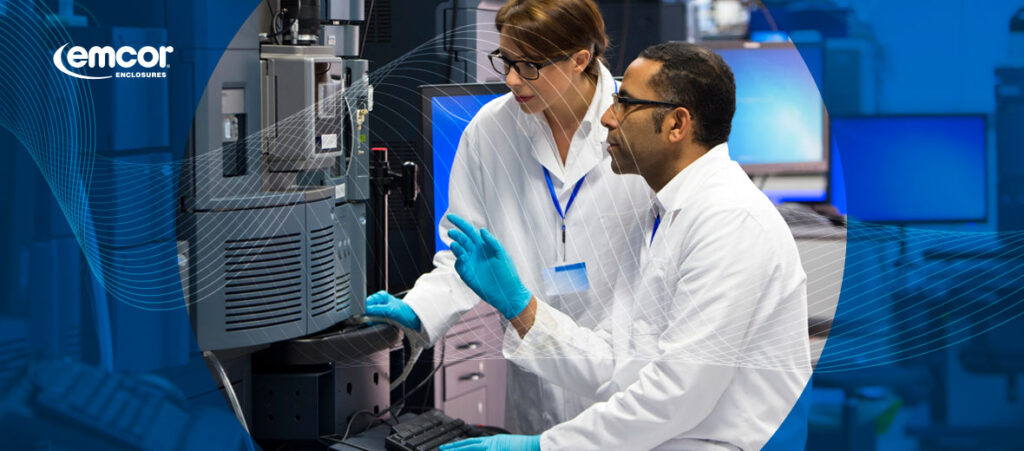Trends in the Test and Measurement Industry

All devices must undergo rigorous quality and safety testing before they can reach the market. Manufacturing plants and medical facilities rely on specialized testing and measuring equipment to accurately evaluate their products and detect possibilities for improvement.
In this context, the test and measurement (T&M) equipment industry is looking at sustained growth over the next decade. Market forecasts project the market to grow at a CAGR of 5.6% from 2022 to 2032. Companies looking to take advantage of this growth must pay attention to evolving trends within the industry to guide their strategy moving forward.
The Impact of COVID-19 on the Test and Measurement Industry
While most industries suffered losses due to the economic slowdown of the COVID-19 pandemic, the test and measurement equipment industry flourished — and it’s still growing. Due to rising demand for medical equipment and appliances, which must meet stringent quality control standards to receive approval for use, demand also increased for high-quality T&M equipment. Understanding how to harness this growth will be key for the industry in the future.
Key Test and Measurement Industry Trends for 2023
The T&M industry encompasses more than equipment manufacturing and sales — expanding your view of the market can help you identify and capture new opportunities for growth. Here are some of the most promising industry trends experts have observed.
1. Modular Instruments
T&M equipment is becoming increasingly complex — and more costly. While test systems must be able to integrate new device changes over time, the ability to extend their lifespans is critical for keeping overall costs low.
Software-defined modular hardware design will be critical for meeting these needs moving forward. Some of the primary benefits of modular T&M instrumentation include:
- Flexibility: User-defined software allows you to expand the functionality of your hardware, so you can quickly adapt if your needs change.
- Scalability: Well-designed modular instrumentation systems share components across modules, which enables easy integration any time you need to add a new module.
- Cost savings: Shared components, including the chassis, processor and backplane, reduce your need to purchase additional equipment.
2. Software Upgrades
Because purchasing new T&M equipment is a significant investment for most facilities, providing software that can expand device functionality is a profitable opportunity for many manufacturers and software companies.
Equipment suppliers often offer continuous software upgrades that allow customers to keep up with evolving testing needs. This maintains the business relationship between supplier and customer even when the customer does not need to purchase new equipment.
Companies looking to remain competitive should prioritize differentiating themselves through iterative software releases rather than focusing on selling new equipment. With the recent growth of the cloud in digital transformation, shifting to a cloud-based software-as-a-service (SaaS) business model is likely to be the most lucrative route.
3. Calibration and Repair
Equipment failure is not an option in tightly regulated industries like defense and healthcare. If even one device misreads a measurement, it could have devastating consequences. And product quality and safety standards are steadily tightening.
And with the increasing complexity of testing equipment and the rising costs of purchasing new equipment, it’s becoming more difficult for facilities to calibrate and repair equipment in-house.
Providing calibration and repair services offers promising revenue opportunities for original equipment manufacturers (OEMs) and suppliers. Many suppliers include these services as part of their initial sales package, which helps them to retain customers. You could also offer stand-alone services to bring in new customers.
Challenges for the Test and Measurement Industry
Here are some of the biggest challenges the T&M industry will face moving forward.
1. Diversity of Instruments
The increasing use of complex, interconnected systems like the Internet of Things (IoT) has expanded the global T&M market far beyond standard testing and measuring equipment.
Digital transformation is the primary driver of this evolution. Technologies like 5G connectivity, which enable high-performance virtualization and automation, have become more essential to companies across all industries. Testing equipment must adapt to meet these new requirements.
Adopting modular equipment and consumer electronics will help users adjust to the rapidly growing number of testing tasks. Modular architecture allows you to meet all requirements of each application without having to purchase new equipment, saving valuable money and time.
2. The Rise of IoT
The IoT consists of a network of internet-connected sensors and devices that collect and process massive quantities of data. Adapting to IoT testing at every level — network, wireless communications and device — is vital for factories and healthcare facilities containing many connected devices. However, creating testing devices that can include all these new functionalities will be a major challenge for the industry.
3. Calibration and Repair
In today’s rapidly evolving tech landscape, it can be challenging to keep up with changing standards and regulations. With the increasing complexity of T&M equipment, calibration, in turn, becomes a more complicated procedure. Facilities not yet outsourcing calibration and repair services may need to do so to ensure they can meet new requirements.
Versatility will also be critical for suppliers in gaining a competitive edge in calibration and repair services. Mobile or in-facility servicing is a convenient option for customers who need to minimize downtime to maintain high throughput and revenue generation.
The Future of Test and Measurement
Moving forward, we’re likely to see significant change in the T&M industry, specifically in device innovation and design. Companies investing in this new equipment will need to find ways to extend the devices’ lifespans.
High-end test and measurement systems require modular enclosures to protect the sensitive electronics. Enclosures shield components from external risk factors like electromagnetic interference (EMI) and environmental vibrations.
Some considerations for choosing enclosures include:
- Physical footprint: Your test equipment racks should be compact enough to easily move into your facility as well as fit your installation space. Custom-designed enclosures can ensure your investment meets your unique needs.
- Heat dissipation: Test and measurement devices generate significant amounts of heat, which can damage your equipment if managed improperly. An enclosure with consistent airflow and heat dissipation features can significantly reduce this risk.
- Shock and vibration protection: Long-term exposure to shock and vibration can degrade your testing equipment and reduce performance. Because every facility has unique risk factors, designing an enclosure system that protects against your specific environment is critical.
An enclosure system from Emcor Enclosures is a cost-effective, durable investment that will help your facility navigate the changing T&M landscape.

Choose Emcor for Custom T&M Enclosures
At Emcor Enclosures, we offer premium custom and turnkey electronic equipment enclosures to customers worldwide. Our modular test equipment accessories, racks and enclosures conform to high-quality manufacturing standards, making them suitable for use in a wide range of industries. Plus, we offer custom enclosure design consulting services, so when you partner with us, you can create an enclosure system that meets your unique specifications.
Contact us to learn more about our products and services, or click here to find a rep near you.